Crate training a rescue dog can feel like trying to win over a shy new friend, but with the right approach, it becomes a rewarding experience for both of you.
Did you know dogs are natural den animals? That means most dogs actually enjoy small, cozy spaces once they feel safe. The crate can become that perfect spot, like a bedroom retreat with all the peace and quiet.
If you've just welcomed a rescue into your life and plan on implementing a crate, keep reading. We'll show you how to make crate training simple, positive, and even a little fun. Let's turn that crate into a happy place!
Why Crate Training Can Help Rescue Dogs Feel Safe

Crate training a rescue dog provides them a personal retreat where life feels less scary. Many rescue dogs come from noisy shelters or homes full of chaos. A dog crate creates a calm zone with a door open to peace, not pressure. This simple setup helps anxious behaviors fade and teaches your rescue pup they have finally landed somewhere safe and cozy.
Creating a Secure, Calm Space After Adoption
After adoption, everything feels new for a rescue dog. Sounds, smells, and routines can be overwhelming. A crate becomes a safe space where they can relax and take a breather. It is like giving your dog a bedroom made just for them. Make the crate feel cozy with a favorite toy, soft bedding, and a few treats. Put it in the same room you spend time in so your dog feels included and calm.
How Crates Support Routine, Confidence, and Healing
Rescue dogs do best when life feels predictable. Crate training helps build steady habits like house training and regular crate time. These patterns show your dog what to expect and when. Over time, that structure creates confidence. The crate turns into more than just a tool. It becomes a peaceful corner of their world where comfort, trust, and healing start to grow.
Understanding Your Rescue Dog's Background
Every rescue dog has a story. Some come from loud shelters, others from homes that didn't work out. Each one carries pieces of their previous life into their new space. Before you start crate training, take a moment to understand your dog's world. The next few sections will help you learn what they've been through and how to guide them with a calm, positive approach.
Trauma, Transitions, and Adjustment Periods
Crate training a rescue dog works best when you understand how change affects them. Many dogs feel unsure in a new environment, especially after bouncing between homes or dealing with chaotic kennels. That's why a safe space, like a dog crate with a crate door left open, helps them feel grounded.
Most dogs need time to adjust. Use the crate as a calm zone, not a quick fix. With positive reinforcement and a few treats, your dog will begin to feel safe and settle in.
Signs Your Dog May Need Extra Patience
Not every rescue settles in the same way. Some need extra time, especially older dogs with stressful pasts. Watch for these signs during crate training or house training:
- Whining during crate time
- Hesitating to enter small spaces
- Hiding from dog owners or family
- Avoiding the crate door
- Pacing in the same room
- Restlessness after a long walk
Slowly work through these moments with a positive approach, short periods, and positive associations inside the crate.
Choosing the Right Crate for a Rescue Dog
The right crate makes a big difference when crate training a rescue dog. It should feel like a cozy den, not a cage. Pick a dog crate that gives enough room to stand, turn, and rest with a favorite toy. A larger crate may work better for adult dogs or those still growing. Comfort matters from the first week.
Size, Style, and Setup Tips for Comfort
Choosing the right crate means thinking about more than just size. Your rescue dog needs space to stretch, but not so much that they feel lost inside. Wire crates offer airflow, while plastic ones feel snug. Add soft bedding, treats, and a favorite toy to make the crate feel like home. When you start crate training, comfort sets the tone for positive experiences and helps your dog feel safe.
Where to Place the Crate in Your Home
Pick a calm spot where your rescue dog can still see the action. The laundry room, corner of the living room, or bedroom are great choices. Keep the crate door open so your dog can explore without pressure. Most dogs relax better when their crate is in the same room as their favorite people. A quiet spot helps prevent destruction and supports a smooth new environment adjustment.
Crate Training Tips for Rescue Puppies and Adult Rescues
Crate training a rescue dog works for both young puppies and older dogs, but each one needs a slightly different approach. The goal stays the same—help them feel safe, secure, and stress-free. The next few tips offer a fun, step-by-step guide to build confidence and trust, no matter your dog's age or previous life experience.
Make the Crate a Positive, Safe Space
Start crate training by making the crate feel cozy and inviting so your rescue dog views it as a place of comfort, not confinement. Use soft bedding and a favorite toy to create a space that feels warm and familiar, reducing any fear of small spaces. Leave the crate door open during the first week to encourage free exploration and prevent the dog from feeling trapped. This helps build trust and allows your dog to make positive choices on their own.
When your dog steps inside willingly, immediately reward them with a few treats or gentle praise. These small wins create positive associations, making it more likely they'll return to the crate on their own.
Use Rewards to Reinforce Calm Behavior
Positive reinforcement helps your dog learn that staying peaceful inside the crate leads to good things. Reward your dog with a tasty treat, favorite toy, or gentle praise whenever they enter the crate on cue or rest quietly inside. Over time, this builds a strong pattern of positive crate time.
A few more treats during each training session can help speed up progress by turning crate time into something enjoyable. You're not just training—you're showing your dog that the crate is part of the good stuff in life. This approach helps prevent destructive behavior and builds confidence inside the crate.
Establish a Routine for Potty Breaks and Sleep
Having a regular schedule makes crate training and house training smoother, especially for a young puppy. Take them outside after crate time, meals, naps, or play to avoid accidents and support a clean routine. For adult dogs adjusting to a new home, feeding and resting at consistent times can help them feel safe and grounded.
Crate time after meals helps your dog understand when it's time to rest versus when it's time to play. These patterns also prevent overstimulation and support better sleep habits. Over time, your dog will begin to expect and enjoy the rhythm of daily life.
Start With Short, Positive Alone-Time Sessions
Once your dog is relaxed inside the crate, it's time to teach them to be okay with being alone for a bit. Begin by leaving the room for just a few minutes while your dog stays inside the crate with a treat or favorite toy.
Slowly work up to longer stretches, always returning before your dog starts to feel upset. This helps prevent fear of being alone and builds trust in the process.
Keep the crate time relaxed by avoiding sudden exits or big greetings when you return. The goal is to show your dog that being inside the crate while you're away is normal and nothing to worry about.
Be Patient With Hesitant or Nervous Dogs
Some dogs need extra time, especially if their previous life included fear or stress. Rebuilding trust takes care, patience, and a gentle hand. Here's how to support them in a positive way:
- Slow Introductions Are Key. Give your dog time to explore the crate without pressure. Place a few treats inside the crate and let them enter at their own pace. Keep sessions short to avoid overwhelm.
- Use a Calm, Gentle Voice. Speak softly when near the crate to build comfort. Loud sounds or fast movements can scare nervous dogs. Calm behavior from dog owners encourages a calm response from your pup.
- Keep the Door Open at First. Avoid closing the crate door right away. Let your dog see the crate as a free space they can exit anytime. Once they feel confident, you can slowly work toward short crate time with the door closed.
- Stick to a Predictable Schedule. Consistency helps nervous dogs feel safe. Use the crate at the same times each day—after meals, before naps, or when you're doing chores. A regular routine helps them feel more secure in the new environment.
- Celebrate Small Wins. Even small steps deserve praise. If your dog spends time inside the crate or stops whining, offer a reward. Building trust takes time, but positive experiences make all the difference.
Mistakes to Avoid During Crate Training
Even the best dog owners can make a few missteps while crate training a rescue dog. The trick is to stay patient and avoid rushing the process. Some common mistakes can slow progress or create negative feelings. The next few tips will help you steer clear of those bumps and keep things moving in a positive direction.
Never Force Crate Time or Use the Crate as Punishment
A dog crate should always feel like a safe space, not a timeout corner. If you send your rescue dog to the crate after accidents or unwanted behavior, they may start to associate the space with fear and rejection rather than comfort. This can create long-term hesitation or even refusal to enter the crate, which works against your training goals.
Using the crate as a punishment or forcing crate time can also trigger anxious behaviors and make house training more difficult. Instead, offer a few treats or a favorite toy when they enter voluntarily, and speak to them in a calm tone. Your dog should see the crate as a place they choose to go when they want to relax, not where they're forced to go when they've done something "wrong."
Skipping Steps or Moving Too Fast
Crate training a rescue dog is not something to rush, even if your pup seems to adjust quickly. Skipping key steps like slow introductions or gradually increasing crate time can cause stress that shows up later through whining, pawing, or avoidance.
Most dogs, especially those with a tough previous life, do better with a structured approach that builds trust step by step. For example, leaving the crate door open during early sessions helps prevent your dog from feeling trapped.
Over time, you can gradually increase crate time with the door closed, always monitoring for signs of discomfort. The more consistent and patient you are, the more confident your dog will feel inside the crate.
Natural Tools to Support the Crate Training Process
Crate training a rescue dog works even better with a few natural tools to set the mood. Think of these as helpful extras that make the crate feel warm, welcoming, and safe. The next tips include calming treats, comfort items, and relaxing routines that support a positive crate experience for your pup.
CBD for Calming and Soothing Transitions

Sometimes, crate training needs a little extra support. Natural CBD may help calm nervous behaviors and make your dog feel more balanced in their new environment. Here are some helpful and reliable options to explore.
- CBD Calming Chews for Overactive Dogs. These soft treats contain CBD, chamomile, and L-tryptophan to relax nerves and support mood. Perfect for dogs who bounce off the walls, bark nonstop, or struggle with crate time.
- CBD Wellness Treats for Daily Balance. Made with blueberries, flax seeds, and hemp seed powder, these vegan-friendly treats support overall wellness. Broad-spectrum CBD oil helps regulate your dog's mood without any THC.
- Safe and Natural Ingredients. Every HolistaPet product is THC-free and crafted with care. These treats are a natural addition to your dog's daily routine, helping them adjust to new spaces like a dog crate without worry.
Enrichment Toys, Chews, and Treats to Reduce Boredom
Adding fun distractions during crate time can make a huge difference. Toys and treats help prevent destructive behavior and ease nervous energy. These options give your dog something fun to focus on while inside the crate, turning alone time into a treat.
- Frozen peanut butter in a chew toy
- Lick mats with soft food spread across
- Long-lasting chews or puzzle feeders
- A few more treats hidden in toys
- Enrichment toys that squeak or rattle
Familiar Blankets or Items With Your Scent
A rescue dog finds comfort in familiar smells, especially when adjusting to a new environment that feels overwhelming or unpredictable. Your scent offers a sense of connection and security, reminding your dog they are not alone even when you're out of sight.
Placing a blanket, T-shirt, or even a pillowcase you've used inside the crate can ease your dog's nervous behaviors during crate time. This helps reduce the fear of separation and supports a smoother transition to crate training.
Over time, your scent becomes a cue that the crate is a safe and trusted place to rest. It's a simple but powerful way to build positive associations without adding extra stress.
Calming Scents, Soft Music, or White Noise
Soft background sounds help mask sudden noises that could startle a rescue dog and disrupt crate training progress. Playing white noise, nature sounds, or soft instrumental music can make the crate feel like a peaceful, safe space, especially in a busy home or during loud events like thunderstorms.
Calming sprays made with pet-safe essential oils like lavender or chamomile may also help reduce agitation. A light mist on the crate bedding or surrounding area can create a more relaxed atmosphere. These gentle tools support consistent crate time by promoting calm, quiet behavior.
Together, sound and scent offer non-invasive ways to help your dog feel more comfortable in their new environment.
Final Thoughts – Rescue Dog Crate Training
Crate training a rescue dog takes patience, love, and the right tools, but the rewards are worth it. You're giving your dog a calm, safe space to rest, reset, and feel at home in their new life. From picking the right crate to building trust with short crate time sessions, every small step matters.
Don't forget the extras that make a big difference, like soft bedding, enrichment toys, and HolistaPet's calming CBD treats. Our CBD products for dogs and cats are made to support relaxation, daily wellness, and smoother transitions. With your care and a positive approach, your rescue pup can learn to love their crate and enjoy all the comforts of their new forever home.



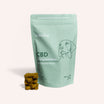

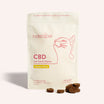
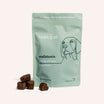
![Probiotics For Dogs [Soft Chews] - HolistaPet](http://www.holistapet.com/cdn/shop/files/Probiotic-Infographic-1_472d7a29-e30c-435a-9638-1365d8c3a9f9.jpg?v=1725384841&width=104)
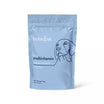



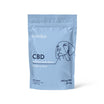
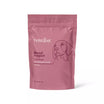
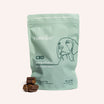

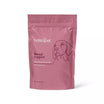
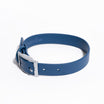
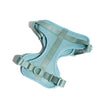
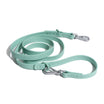
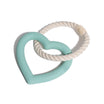
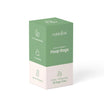
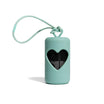

 Broad Spectrum CBD Oil for Dogs - Fast Acting
Broad Spectrum CBD Oil for Dogs - Fast Acting
 Chicken Flavored CBD Oil For Dogs - Easy Dose
Chicken Flavored CBD Oil For Dogs - Easy Dose
 Salmon Flavored CBD Oil For Dogs - Highly Rated
Salmon Flavored CBD Oil For Dogs - Highly Rated
 CBD Dog Treats for Anxiety - Loved by Thousands
CBD Dog Treats for Anxiety - Loved by Thousands





Leave a comment
All comments are moderated before being published.
This site is protected by hCaptcha and the hCaptcha Privacy Policy and Terms of Service apply.